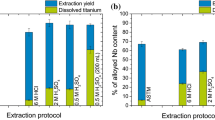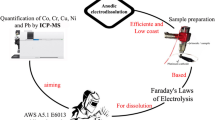Abstract
A novel automated liquid/liquid extraction system was developed for the determination of trace contaminants in unalloyed, alloyed and highly alloyed steels and super alloys. In the presented batch extraction system the aqueous phase and the non-water miscible organic phase were brought into close phase contact by high-speed stirring with a magnetic stir bar. Iodide complexes of Ag, Bi, Cd, Pb, Sb, Sn, Tl, and Zn were extracted from aqueous steel digests into 4-methylpentan-2-one (MIBK) containing 20 g L−1 trioctylphosphine oxide. Ag, Bi, Cd, Pb, and Tl were extracted quantitatively whereas the extraction yields of Sb, Sn, and Zn were 83%, 61% and 75% respectively. Using high resolution continuum source flame AAS (HR-CS-FAAS) for analyte quantification the method was validated using 21 certified steel reference materials (CRMs).






Similar content being viewed by others
References
Melford DA (1966) J Iron Steel Inst 204:495
Zou Z, Grinder O (1982) Scand J Metall 11:79–84
Mayer G, Clark CA (1974) Metallurgist Mater Technol 116:491–501
Wiltsche H, Günther D (2010) Anal Bioanal Chem. doi:10.1007/s00216-010-4605-8
Xing Y, Xiaojia L, Haizhou W (2007) Int J Mass Spectrom 262:25–32
Coedo AG, del Monte Tamba G, Kuss M, Dorado T, Padilla I (1998) ICP-MS in the iron and steel industry European Commission, Bruxelles
Montaser A (1998) Inductively coupled plasma mass spectrometry. Wiley, New York
Wiltsche H, Brenner IB, Prattes K, Knapp G (2008) JAAS 23:1253–1262
Wiltsche H, Brenner IB, Knapp G, Prattes K (2007) JAAS 22:1083–1088
Silvestre CIC, Santos JLM, Lima JLFC, Zagatto EAG (2009) Anal Chim Acta 652:54–65
Marcus Y, Kertes AS (1969) Ion exchange and solvent extraction of metal complexes. Wiley Interscience, London
Venkaji K, Naidu PP, Rao TJP (1994) Talanta 41:1281–1290
Williams MC, Cokal EJ (1986) Anal Chem 58:1541–1547
Reddy MLP, Preetha GP, Meena CV, Rao TP, Iyer CSP, Damodaran AD (1996) J Radioanal Nucl Chem 211:305–316
Jia G, Torri G, Petruzzi M (2004) Appl Radiat Isot 61:279–282
Kelkar A, Prakash A, Afzal M, Panakkal JP, Kamath HS (2010) J Radioanal Nucl Chem 284:443–449
Schulz WW, Navratil JD, Talbot AE (1985) Science and technology of tributyl phosphate. CRC, Boca Raton
Burke KE (1972) Analyst 97:19–28
Thornton K, Burke KE (1974) Analyst 99:469–470
Kreuning G, Maessen FJMJ (1987) Spectrochim Acta B 42B:677–688
Acknowledgments
The authors wish to acknowledge the support from Boehler Edelstahl GmbH (Kapfenberg, Austria). Mr. Bernhard Pichler is thanked for the helpful discussions and the preparation of several steel dissolutions. The provision of a modified control software for the HR-CS-AAS instrument by Analytik Jena AG is acknowledged. This software modification allows instrument remote control and is now part of the software delivered with new instruments.
Author information
Authors and Affiliations
Corresponding author
Additional information
Published in the special issue Analytical Sciences in Austria with Guest Editors G. Allmaier, W. Buchberger, and K. Francesconi.
Rights and permissions
About this article
Cite this article
Wiltsche, H., Prattes, K. & Knapp, G. A novel approach for an automated liquid/liquid extraction system—principle and application for the determination of several trace contaminants in highly alloyed steels and base alloys. Anal Bioanal Chem 400, 2329–2338 (2011). https://doi.org/10.1007/s00216-011-4666-3
Received:
Revised:
Accepted:
Published:
Issue Date:
DOI: https://doi.org/10.1007/s00216-011-4666-3




